The Chord Qutest audiophile DAC is a small form factor $1,595 dedicated digital-to-analog converter designed for both audiophile and desktop solutions. Made in England, this diminutive DAC is built to survive any possible unforeseen nuclear fallout, with its thick aluminum case and pleasantly robust buttons. There are no fancy features on the Chord Qutest DAC, like volume control, a remote or anything more advanced, as it is thankfully focused on getting your digital signals from the world of zeros and ones into an analog signal that your preamp can work with. We like simplicity around here.
The need for a good DAC in a modern audiophile system is higher than ever, as the 2022 RIAA (all-time high, record) numbers show more music sold than any other year in history, but only eight percent of these sales were made to people buying Compact Discs and/or vinyl. That will make some audiophiles go crazy, just like when they were told that they couldn’t buy their software on a DVD anymore, but progress is progress, and we now live in a streaming world filled with all-access to pretty much every recording made, often in 24-bit files. The Chord Qutest DAC is ready for DSD and PCM files of all sorts. In the approaching-$2,000 price range, there is steep competition, as well as other, much less expensive DACs from the Chi-Fi world that also demand attention. Is the Chord Qutest worthy of a spot in your rack? That’s what we are here to discuss.
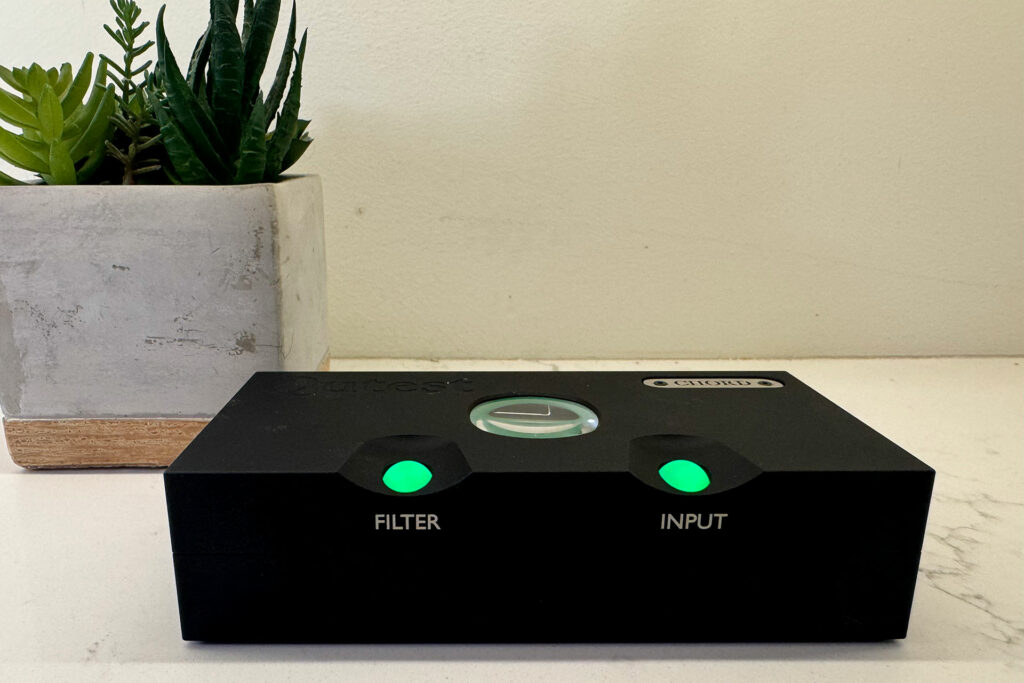
What Makes the Chord Qutest DAC So Special?
- As I mentioned before, the Chord Qutest DAC is built like a brick shithouse. Seriously, this simplistic DAC is small but heavy, and has a feel like you could throw it through a huge plate glass window, pick it up and play it without missing a beat. This DAC is a serious component, even if it fits in the palm of your hand.
- The Chord Qutest DAC can take many different inputs. This includes USB-B, BNC, COAX and Optical. I used COAX and Optical for my listening, and couldn’t hear much of a difference between the two.
- The Chord Qutest DAC matches other smaller products in the Hugo line of Chord products, which are designed to be small yet powerful. A phonostage is offered. Andrew Dewhirst has one of their small form factor integrated amps in for an upcoming review. Stay tuned for that.
- HD sources aren’t a problem with the Chord Qutest, as the DAC’s custom chip can accept both DSD and PCM feeds from today’s highest-resolution 24-bit sources.
- While all DACs have a filter (or upsampling) after the Nyquist Frequency (around 12k), which removed ugly noise from a digital component like a DAC, the Qutest has specific user-accessible filters designed to change the sound of the DAC, like tone controls. Some folks don’t believe DACs should change the sound of a system, and I tend to fall into that group, but others like to change the sound to meet their specific tastes, and the Chord Qutest DAC has a few easily accessible filters that you can use if you are so inclined. My most critical listening was done with the user-selectable filters not engaged.
- There are those who make a big deal out of “Made in America,” so shouldn’t we make the same argument for “Made in England”? It seems like that is a rational conclusion to draw, but to ignore what’s going on in places like China and with Chi-Fi would be to bury our heads in the digital sands. There are many serious DACs that are made by OEMs (companies that make gear for other manufacturers often, but not limited to, in China, Vietnam and Taiwan). You can literally feel the excellent build quality in the Chord Qutest DAC in ways that not a single, granted. less expensive Chi-Fi DAC has ever presented to me.
- The Chord Qutest DAC is Roon-tested, so that those using their iPad or laptop with their own music collection can easily connect into a Chord Qutest DAC, and be good to go with all of their ripped or streaming files from any number of sources.
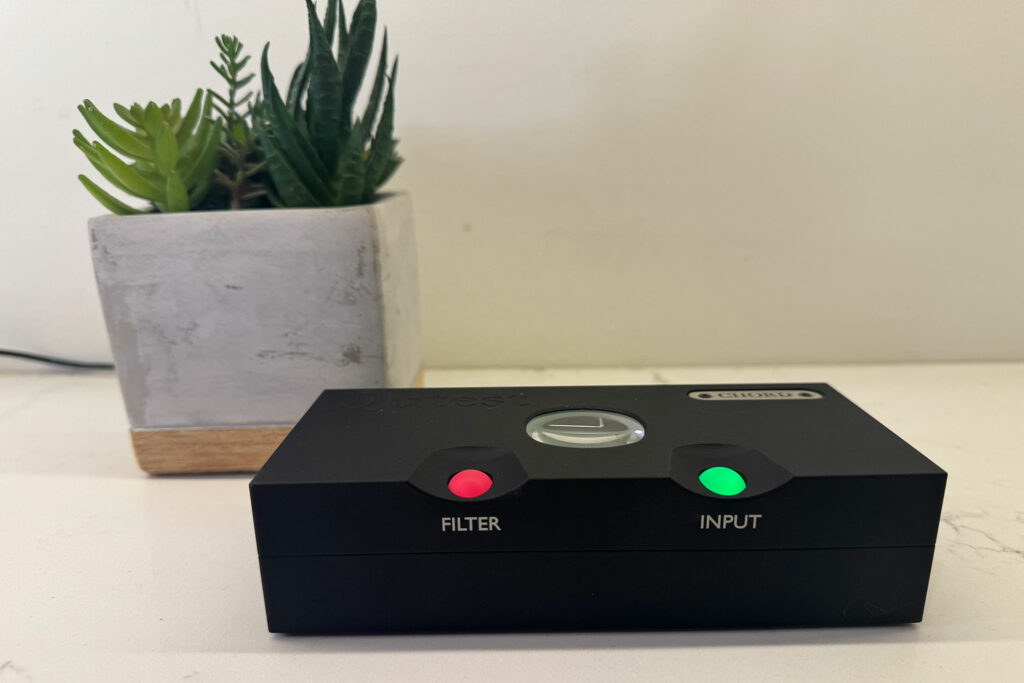
Why Should You Care About the Chord Qutest DAC?
This is an audiophile and desktop audio device, thus has a somewhat greater appeal to more and more music enthusiasts. Being able to pair other desktop-minded components to make a small but very respectable audio system is a strong draw in the desktop community. For the audiophile looking to be ready for the best that both silver discs and streaming has to offer, the Chord Qutest DAC is a worthy offering, even with serious competition in the $1,500 to $2,000 range for a standalone DAC component.
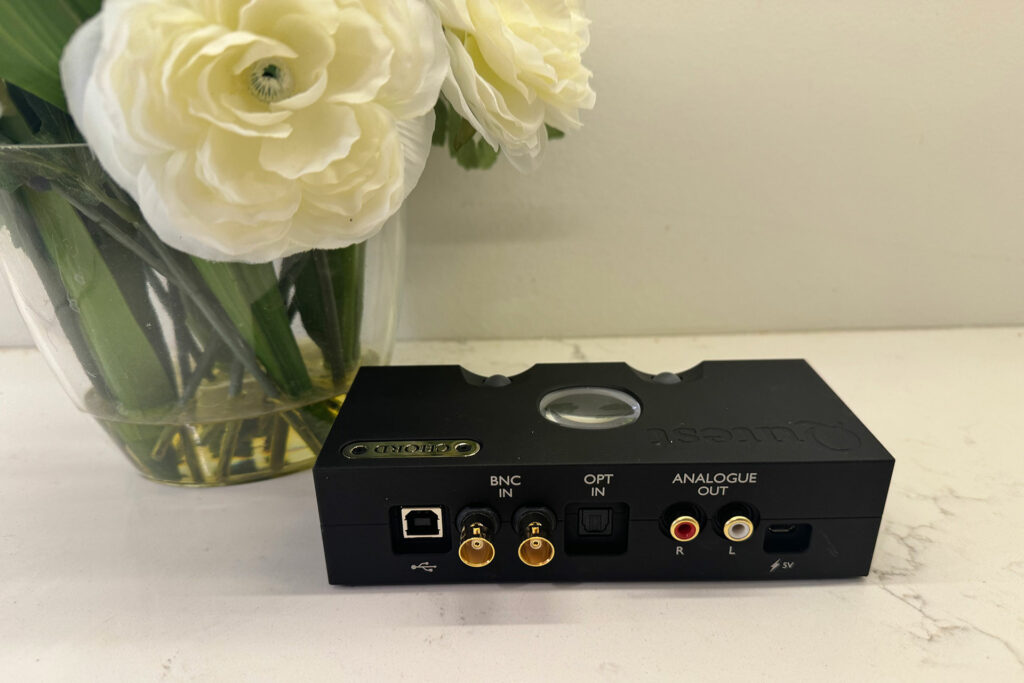
Some Things You Might Not Like About the Chord Qutest DAC…
- There is no remote included in the Chord Quest DAC. Switching inputs and filters is easy on this DAC, as there are two color-coded buttons on the front, but if your listening position is far away or, in my case, behind closed doors – you might wish for a remote for input switching. Since this isn’t a DAC Preamp, I wouldn’t make a major issue out of a lack of a remote control.
- This is not a balanced DAC, thus there are no XLR outputs as you will see with other DACs in this price category.
- While there are many inputs, AES/EBU is not one of them. Beloved in the professional audio world, AES/EBU is a very solid way to connect an audiophile DAC. The Chord Qutest is missing this input. Perhaps it is because of real estate, as AES/EBU cables are comparatively large versus inputs like Optical, BNC or USB-C?
- The power cable is pretty flimsy with a somewhat sizable “wall wart” on the plug end of it. Today’s digital products tend to thrive when using the most robust of power supplies. This goes for DACs, as well as the new-school Class-D amps that have recently taken the audiophile world by storm. The power cable on the Chord Qutest is thin and connects by what looks like Micro or USB-C to the actual DAC unit. While I am anything but an audiophile power cable snob, I was shocked to see a part at this level on a DAC priced at this level.
Listening to the Chord Qutest DAC…
My current system includes a number of DACs, ranging from the Bricasti M3 (read the review) to the Benchmark DAC3 B ($1,895 and also a pro audio favorite). Electronics include an Anthem STR stereo preamp (which has a very capable internal 32-bit up-scaling DAC) and a Pass Labs XA25 power amp (an unbalanced design from Nelson that is really fantastic), paired with Bowers & Wilkins 802 D4 loudspeakers (very close to what is used at Skywalker Ranch and Abbey Road Studios). Wireworld cables were used for most connections.
Musically, I found myself wooed into a guilty pleasure with “Love Will Find a Way” from Yes’ 1980s pop-classic, Big Generator. This is not typical progressive-sounding late 1960s or early 1970s Yes. This is glossy, poppy, highly-produced “sell-out” Yes, but I still love this track (via QoBuz). The somewhat pompous classical intro to the track is presented well on the Chord Qutest DAC. The string instruments have an enjoyable vibrancy to them, but it doesn’t take long to get more into a standard rock song. The spacing between instruments was very good with the Chord DAC in the loop, as the overall sound of the DAC would be best described as comfortable or relaxed, especially when compared to the recently-reviewed Benchmark DAC3 B, which is a much more WYSIWYG sonic solution. The Benchmark has no user filters, and in no way tries to put “makeup” on anything sonically. For many, including reviewers on our staff, that’s just a little too digitally harsh for them. The Chord Qutest DAC, while quite resolute, doesn’t drive around town making you wince as you go over a sonic speed bump. It is much more sonically polite than that.
On a more modern recording, Tom Morello and Dennis Lyxzen of the band Refused “Save Our Souls” brings a more bombastic, all-out rock mix to the table, and the Chord Qutest DAC did really well with this track. Morello is one to “smash the dynamic window” musically, and this track is yet another example. Musically, things build until the chorus, when the recording (this time from CD 16/44.1) gets interesting. That polite sound that I described on a less intense Yes pop track comes in handy with this more ballsy, modern and heavy mix. You can hear the burning sound of Morello’s guitar and his avant-garde playing style. At the chorus, there is a good sense of coherence, meaning that the mix doesn’t collapse or get overly harsh when things get musically quite intense. A track like this might be where some go to add in a user filter, and I understand that, but that’s not really how I roll. I want to hear all that is on the recording without anything in the way, thus I was not getting up to change filters too often, as the Chord Qutest did a very solid job playing back this highly demanding modern recording.
How well does the Chord Qutest do with the best of recordings? I got you covered with “North Dakota” from Lyle Lovett’s all-time audiophile classic, Joshua Judges Ruth from 1992, at CD resolution streaming from Amazon Music. This is a very quiet, open-sounding record and, even without the benefit of 24 bits via streaming, it still sounds fantastic. When Rickey Lee Jones makes her way into the duet, it is easy to hear how the depth and complexity of the vocal harmonies come together. The percussive pops and thuds were lively and musically engaging, even if they were a little musically out of the box for percussion. Simply put, the Chord Qutest DAC is just as capable of playing back the most gorgeous of recordings as it is able to handle today’s ultra-demanding hard rock tracks like the Tom Morello one mentioned above.
Will the Chord Qutest DAC Hold Its Value?
The Chord Qutest DAC isn’t crazy expensive in the pantheon of today’s traditional audiophile DACs. There is downward pressure on the long-term price of DACs like this from the Chi-Fi world, which tends to not even come close in terms of price. They also don’t deliver on the same level of build quality, support and whatnot. Chord products are well-reviewed and well-distributed, which is a vote of confidence for future value. The desktop appeal of the Chord Qutest DAC is helpful in terms of value, too. Digital products like DACs that aren’t easily software- or firmware-upgradable (today’s crazy-expensive DACs are more easily upgradable than high-end DACs of the recent past) tend to be the components that lose the most value over time, but I have a good feeling about the Chord Qutest, as there are a lot of reasons why it will remain relevant over time.
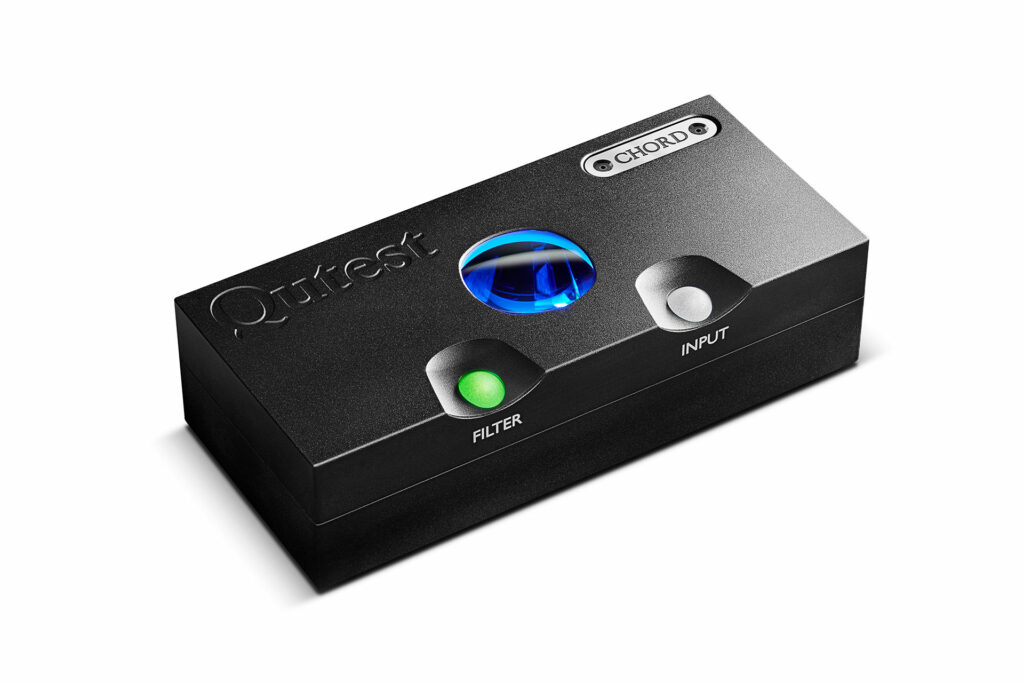
What Is the Competition for the Chord Qutest DAC?
The aforementioned Benchmark Media DAC3 B or L (buy at Amazon) has gained popularity in the audiophile world, but it really is a champion in the pro audio world. This half-rack-width DAC is small in form factor and is priced in the same ballpark as the Chord from the UK. The Benchmark DACs (I think there are three options) can be standalone DACs or a DAC preamp when you invest upwards of $2,300 into it. They use multiple DAC chips to attain very low jitter. Their DACs are balanced in operation, and they take in pro connections like an AES/EBU connection. Sonically, the Benchmark is about as revealing a DAC as you can find. Some love that sound (I do), but for others it is just a little bit too much sonic reality. There are no user selectable filters to soften anything, so if you are expecting to hear The Dead Kennedys Fresh Fruit For Rotting Vegetables on CD from 1980 sound like Dark Side of the Moon or Joshua Judges Ruth, you are going to be disappointed. The Chord Qutest DAC has a more palpable, easy-to-digest sound for lots of different types of music.
The Topping D70 is a Sabre chip powered $699 DAC (buy at Amazon) that is a popular Chi-Fi option for far less money. The DAC has Bluetooth connectivity as well as balanced operation. It supports (through upscaling, one would assume) 32-bit sources. This is a smaller DAC, but it is bigger than the Chord. It comes with a control knob, a remote and an LED screen, which is pretty cool. It doesn’t come with the extreme build quality of the Chord or “made in the UK” credentials, but this is a truly fine DAC in its price category and worthy of a mention with more expensive players like the Chord Qutest.
The PS Audio Stellar Gold DAC ($4,000 – read the review) is coming, but hasn’t arrived yet. PS Audio is known for working with some of the best digital designers in the world to deliver some very capable audiophile components. Priced in the same neighborhood as the Benchmark and the Chord, this is a likely good comp for the Chord. Expect some more thoughts on this DAC once it arrives at Casa Del Colliano for review any day now.
Other DACs that come to mind include the Michael Zisserson-reviewed Schiit Yggdrasil+ OG DAC (read the review of this $2,700 DAC here), which is absolutely not Chi-Fi, but comes from the most no-nonsense audiophile company out there, Schiit. Greg Handy is currently reviewing the Eversolo DMP-A6 ($859 buy at Amazon), as well as the Eversolo DMP-A6 Master Series Streamer DAC ($1,299 buy at Amazon). The Eversolo products do a lot more, like streaming for less money than the Chord and, sonically, early indicators suggest that the Chord DAC will be a top performer, but the Eversolo stuff has gotten a lot of forum hype, thus they deserve at least a mention here, right?
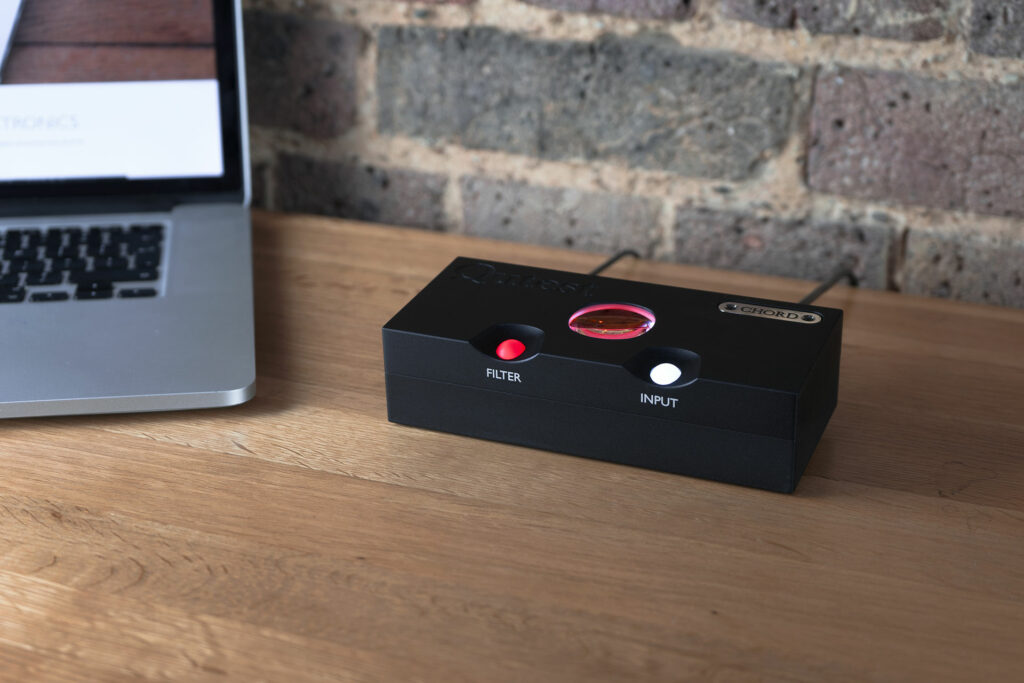
Final Thoughts on the Chord Qutest…
The pedigree of the Chord Qutest DAC is as strong as its overall sonic presentation. We live in a streaming world and, even if you haven’t gone all the way over to streaming (meaning that you still have your music locally as I do, on a network drive), this DAC has you covered for all types of music that you might want to enjoy.
The Chord Qutest DAC is a versatile, easy to set up and easy to use audio component that is as at home in an audiophile rack as it is plunked down on your desk. Paired with its desktop brethren, you have a small form factor army of audiophile components that could make for a kickass overall system for the modern world. But desktop audio isn’t our focus at FutureAudiophile.com, as we are more into traditional, two-channel configurations, for which the Chord Qutest DAC is a really capable stereo DAC that should give you years of strong performance at a very fair price.




Good review.
Thank you!! 🙂